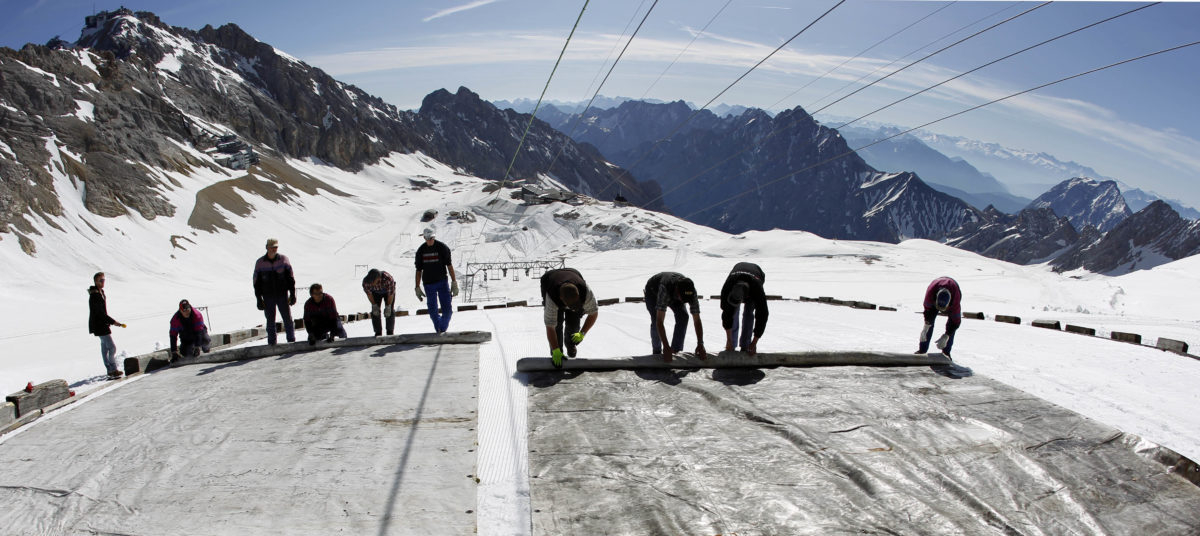This article was originally published by Reveal on March 22, 2018. It was republished as part of Climate Desk, a journalistic collaboration dedicated to exploring the impact — human, environmental, economic and political— of a changing climate.
Next month, a Silicon Valley engineer plans to head out on a snowmobile from Barrow, on the northern tip of Alaska, to sprinkle reflective sand on a frozen lake to try to stop it from melting.
It’s part of a journey that began in 2006, after Leslie Field watched the climate change documentary “An Inconvenient Truth” and felt like she’d been “hit by a big fat truck.” Now, she hopes to gather global support to cover more than 19,000 square miles of sea ice – an area about the size of Costa Rica – with a thin coating of tiny floating silica spheres, which she claims will help reduce the world’s rising temperatures.
The cost estimate? $1 billion a year.
“I keep thinking, ‘If not me, who?’ ” Field, a former researcher at Chevron Corp. and HP Labs, said as she led a reporter through a wholesale flower shop that shares access with her office.
In the emerging field of geoengineering, which envisions large-scale efforts to fight climate change by directly manipulating the natural environment, Field’s privately funded Ice911 project is a small player. Under the Trump administration, these eclectic, messianic and mostly untested projects have been gaining unprecedented momentum.
For decades, scientists have warned that unchecked climate change will lead to catastrophes and have urged policymakers to curb greenhouse gases at their source. But politicians have dragged their heels, and under President Donald Trump, progress has slowed. The Trump administration has challenged the scientific consensus on climate, moved to repeal curbs on power plant emissions, proposed sweeping cutbacks to renewable energy research and pledged to withdraw from global climate talks.
Amid these developments, some close allies of Trump have taken a seemingly paradoxical stance: While denying climate change is a human-caused problem and rejecting proposals to cut greenhouse gases, they’re promoting what many experts worry is the risky default solution of geoengineering.
In 2009, John Holdren, President Barack Obama’s science adviser, drew backlash after telling an Associated Press reporter that geoengineering has “got to be looked at.” But since Trump took office, advocates of geoengineering research say the political climate for such tactics has warmed. In December, Rep. Jerry McNerney, a California Democrat, introduced an unprecedented bill seeking funds for geoengineering research and development. In February, Trump signed a budget that includes first-ever tax breaks, with bipartisan support, for using new technologies to capture carbon dioxide from the atmosphere, a strategy many experts consider to be a kind of geoengineering.

Republican Rep. Randy Weber, R-Texas, has been skeptical about climate change, but in November he said that “the future is bright for geoengineering.” These untested, large-scale projects would manipulate the natural environment to reduce global warming. Credit: Bill Clark/CQ Roll Call via AP Images
“The future is bright for geoengineering,” Republican Rep. Randy Weber of Texas, chairman of the Energy Subcommittee of the House Committee on Science, Space and Technology, said at a hearing in November.
In the past, Weber has grilled scientists on “global cooling” and rejected a carbon pollution tax as “blasphemy.” Yet at the hearing, he claimed that specific, yet-untested proposals such as “placement of mirrors in space” and “brightening the clouds overhead … could have a cooling effect on our lower atmosphere.”
‘Hacking the planet’
Trump himself has not publicly addressed geoengineering, his budget proposals make no mention of it, and none of his cabinet members has publicly endorsed it. Neither Environmental Protection Agency Administrator Scott Pruitt nor Paul Dabbar, the Energy Department’s undersecretary for science, responded to requests for comment.
Nevertheless, said Harvard University physics professor David Keith, “there’s much more broad support for this than there was just two years ago.”
Keith, who wrote a 2013 book, “A Case for Climate Engineering,” leads one of the world’s most advanced and closely watched geoengineering research projects. Later this year, his team plans to conduct its first outdoor trial, launching a slow-moving balloon over Tucson, Arizona, to disperse substances such as calcium carbonate dust or sulfur dioxide to reflect the sun’s rays back into space. The scientists believe this approach, known as solar radiation management, could mimic the climate-cooling effect of a volcano such as the Philippines’ Mount Pinatubo, whose eruption in 1991 caused a temporary global drop in temperatures of about 1 degree Fahrenheit. Keith estimates full-scale deployment would cost about $1 billion a year.
The increasing interest in geoengineering, including from climate change skeptics, owes partly to growing pessimism about humanity’s capacity – and political will – to ward off the worst effects of climate change without some major technological breakthrough. Microsoft Corp. founder Bill Gates has invested both in Keith’s research and in a for-profit companyKeith founded to try to capture carbon from the atmosphere. In 2015, two major U.S. environmental groups, the Environmental Defense Fund and the Natural Resources Defense Council, supported small-scale research into projects that one writer has dubbed “hacking the planet.”
Several Trump allies are considerably more gung-ho, with some explicitly portraying geoengineering as a cheap alternative to radically transforming a U.S. economy that is still about 80 percent dependent on fossil fuels.
“Instead of forcing unworkable and costly government mandates on the American people, we should look to technology and innovation to lead the way to address climate change,” Rep. Lamar Smith chairman of the House Science, Space and Technology Committee, said at last fall’s hearing.
Smith, a Texas Republican and Trump stalwart heavily backed by the fossil fuel industry, has been one of the most aggressive climate science skeptics in Congress. Yet at the hearing, he called for more research into geoengineering, saying, “Some scientists believe it could achieve substantial environmental benefits at a cheaper cost than regulations.”
Likewise, former GOP House Speaker Newt Gingrich, a devoted ally of Trump’s who has portrayed climate change as the left wing’s “newest excuse to take control of lives,” has also praised geoengineering for its “promise of addressing global warming concerns for just a few billion dollars a year.”
Attorney David Schnare, a Trump transition appointee at the EPA who has since left the administration, has challenged mainstream climate science and filed lawsuits seeking access to climate scientists’ emails, while championing geoengineering as “a means to put off the most catastrophic potential effects” of global warming.
For several years, conservative think tanks, including the American Enterprise Institute, the Hoover Institution and The Heartland Institute, have taken a similarly paradoxical position, challenging established climate science while promoting geoengineering. Scholars working for the American Enterprise Institute’s Geoengineering Project have touted the strategy as “a revolutionary approach to climate change.”
‘Howlingly barking mad’
Over the past several years, scientists and entrepreneurs throughout the world have proposed more than a dozen different kinds of geoengineering projects. One would send 16 trillion tiny robots into space to deflect the sun’s rays from the Earth. Another would build millions of wind-powered pumps in Arctic waters to push freezing water over the ice to thicken it. The “cloud-brightening” scheme praised by Weber last fall envisions shooting salt water into marine clouds to improve their reflective power.
These aren’t even the most radical ideas. Back in 1993, an Indian physicist considered whether the Earth could be cooled by somehow increasing the radius of the planet’s orbit around the sun. And in a widely condemned operation in 2012, a rogue California businessman conducted the world’s largest geoengineering project to date by dumping 100 tons of iron dust into the Pacific Ocean. His goal was to fertilize plankton to absorb carbon dioxide and then sell “credits” to fossil fuel firms.
Solar radiation management proposals, such as the cloud-brightening strategy and the Harvard aerosol-spraying plan, have attracted the most interest from U.S. politicians, even as they’ve caused alarm among leading climate scientists.
“The idea of ‘fixing’ the climate by hacking the Earth’s reflection of sunlight is wildly, utterly, howlingly barking mad,” Oxford University physics professor Raymond Pierrehumbert wrote in a 2015 Slate article. He was a lead author of the Nobel Prize-winning Third Assessment Report from the U.N. Intergovernmental Panel on Climate Change.
In an interview, Pierrehumbert compared such strategies with “jumping off the Washington Monument and hoping somebody invents anti-gravity before you hit the ground.”
He and other scientists say large-scale spraying of sulfur dioxide into the atmosphere, as envisioned by Harvard’s Keith, could deplete the ozone layer, harm some plants and animals, and benefit some countries while causing droughts in others, stirring global conflict akin to nuclear rivalries. Furthermore, barring radical cuts in greenhouse gas emissions, such projects, once begun, might have to be continued indefinitely to prevent worse warming than before, a phenomenon known as the termination effect.
An additional danger, which Keith himself has cited, stems from geoengineering’s potential “moral hazard,” an insurance industry term that refers to how people behave more recklessly when they know they have a fallback. In other words, the promise of geoengineering might convince politicians that they need not worry about reforming our energy economy.
“If we don’t cut emissions, we’re sunk, and it would be criminal if people use this as an excuse to avoid that,” Keith said in an interview with Reveal from The Center for Investigative Reporting.
This is precisely what worries Janos Pasztor, former U.N. assistant secretary-general for climate change, who has been leading a new global effort to improve public discussion and governance of geoengineering proposals. He said the House hearing last fall “sent the wrong signal to the world,” noting that it took place just as world leaders were meeting at the U.N.’s annual climate change conference to discuss ways to lower greenhouse gases.
“At the very same time, U.S. politicians were talking about stopping all these activities that could make a difference and talking about geoengineering, as if it’s some sort of a plan B,” Pasztor said. “It’s not a plan B. Maybe it could give us some time, but it’s not a solution.”
Boots on the ice

In a spring 2017 mission, engineer Leslie Field of California marks an area on North Meadow Lake in Barrow, Alaska, before sprinkling tiny reflective silica spheres on the ice to try to keep it from melting. Field’s geoengineering project would cost an estimated $1 billion a year, and some experts call it unrealistic and ineffective.Credit: Courtesy of Ice911
Field, the Ice911 founder, says she’s also concerned that the promise of a geoengineering fix might sap political will to cut emissions. Yet that hasn’t deterred her from joining other scientists and entrepreneurs rushing into the leadership vacuum.
“I don’t want Ice911 to be an excuse for building another coal mine,” she said. “But we have to do something. Our backs are up against the wall.”
Field, an inventor with 53 patents, began her research with buckets of cold water on the front deck of her home in Portola Valley, California, where she tested a variety of materials, including hay and daisies, to see how well they could prevent the sun’s rays from raising water temperatures. After settling on silica, she scaled up her experiments with trials on ice in California’s Sierra Nevada and on Canada’s Miquelon Lake.
Along the way, she raised funds from private donors, the largest contribution being a three-year, $1.3 million grant from a family foundation she heard about from a wealthy friend with whom she volunteered at her sons’ school. The money has helped pay for land-use permits and logistical support from Ukpeaġvik Iñupiat Corp., an indigenous-run organization in Barrow, Alaska. In May, Field and a small group of volunteers used an agricultural spreader, dragged by a snowmobile, to cover an area of ice the size of three football fields on an inland lake in Alaska.
Next week, Field plans to dispatch a buoy into the Arctic Ocean to monitor sea ice, and then return next month to try dispersing more sand on lake ice. She has not yet secured permits to perform tests on sea ice.
“Ice911 is the boots on the ground solution acting now to ease climate change by restoring Arctic ice,” reads Field’s fundraising pamphlet, what she conceded in an interview was an overstatement. Ice911 has yet to have any impact on climate change. Before that can happen, she said, she needs to build credibility for her approach, which has yet to win respect from the so-called geo-clique – a small group of North American scientists who advise politicians and large funders.
Among Field’s harshest critics is Ken Caldeira, an atmospheric scientist at the Carnegie Institution for Science’s Department of Global Ecology at Stanford University, who has collaborated with Keith and worked with Bill Gates. Caldeira dismissed Ice911 as unrealistic.
“This isn’t anything anyone is going to do,” Caldeira said. “It’s hard to do, not that effective, and you’d have to do it over millions of acres.”
Field disputes this. She said she recently hired climate modelers who she said assured her that Ice911 could lower Arctic temperatures by placing her sand in limited, strategic locations, such as the Fram Strait between Greenland and Svalbard.
“We’re working to simply restore an ecosystem that has a profound effect on the planet’s weather patterns,” she said. “That’s a lot better than putting a known pollutant into our one and only atmosphere.”
Harvard’s Keith, whom Time magazine honored in 2009 as a “hero of the environment,” gives voice, often simultaneously, to the world’s fears and hopes for geoengineering. In the span of a single conversation with comedian and TV host Stephen Colbert in 2013, he called geoengineering “ugly” and “horrifying” but also said, “It might actually save people and be useful.”
Many scientists warn that the longer politicians ignore other strategies, the more likely society eventually will need to make the hard choice to try geoengineering. Still, Keith said he is unnerved by climate change skeptics’ recent embrace of geoengineering.
“In some ways,” Keith said at a conference last fall, “the thing we fear the most is a tweet from Trump, saying, ‘Solar geoengineering solves everything! It’s great! We don’t need to bother to cut emissions.’ ”





Comments